What makes Eric Thames so successful? Plate discipline and raw power

In the age of advanced statistics, there’s never been more ways to understand or evaluate how good each player is. However, there is still no way to accurately calculate how good a player has to be to earn the nickname “God.” Eric Thames is doing his best to force people to figure it out.
Of course, the first fans to call him that weren’t really saying “God” but rather, phonetically, hananim, the Korean word for God or Providence. For before Thames became a folk hero in Milwaukee and the best story early in the 2017 MLB season for smashing eight home runs and batting .359 in 18 games, he first needed to remake himself as a hitter 6,600 miles away in the Korean Baseball Organization with the NC Dinos in the city of Changwon.
Four years ago, Thames was the furthest thing from a baseball deity. After two failed seasons in the majors with the Blue Jays and the Mariners in which he hit a combined .250 with a .727 OPS and 21 home runs, Thames couldn’t catch onto a major league roster in 2013. He spent that season at Triple A, split between the organizations of the Mariners and Orioles, hitting a combined .283/.367/.432. Though respectable, that showing wasn’t enough to bring a major league offer that off-season for a player who was then 27 years old. With MLB’s doors closed, Thames journeyed across the Pacific to South Korea, where he retooled his swing, turned himself into the KBO’s most dangerous hitter and played his way back onto the biggest stage in baseball.
Thames spent three seasons with the NC Dinos, putting up numbers rarely seen in any level of professional baseball. He slashed .349/.451/.721 with 124 homers and 382 RBIs in his three seasons abroad, becoming the third foreign-born player to win the KBO MVP Award in 2015. Thames’s exploits were enough to earn multiple offers from MLB teams this off-season, and he chose to sign a three-year, $16 million deal with the Brewers, where he was guaranteed to be the team’s starting first baseman.
Eric Thames is a legend in Korea, now he's restarting his career with the Brewers
Thames is well on his way to being the National League Player of the Month in April. Now 30, he has a league-leading .828 OPS and a 1.289 OPS. He homered in five straight games from April 13 to 17, that even if his Korean nickname wouldn’t translate, the work he put into his swing would.
“For three years he was his own hitting coach,” said Darnell Coles, who, as the Brewers hitting coach, has taken that responsibility off Thames shoulders.
Using ESPN’s Hit Tracker tool, we can still find all 21 homers he hit in his first go-round in the majors. Comparing his batting stance then and now shows just how dramatically he has changed the way he stands in the batter’s box.
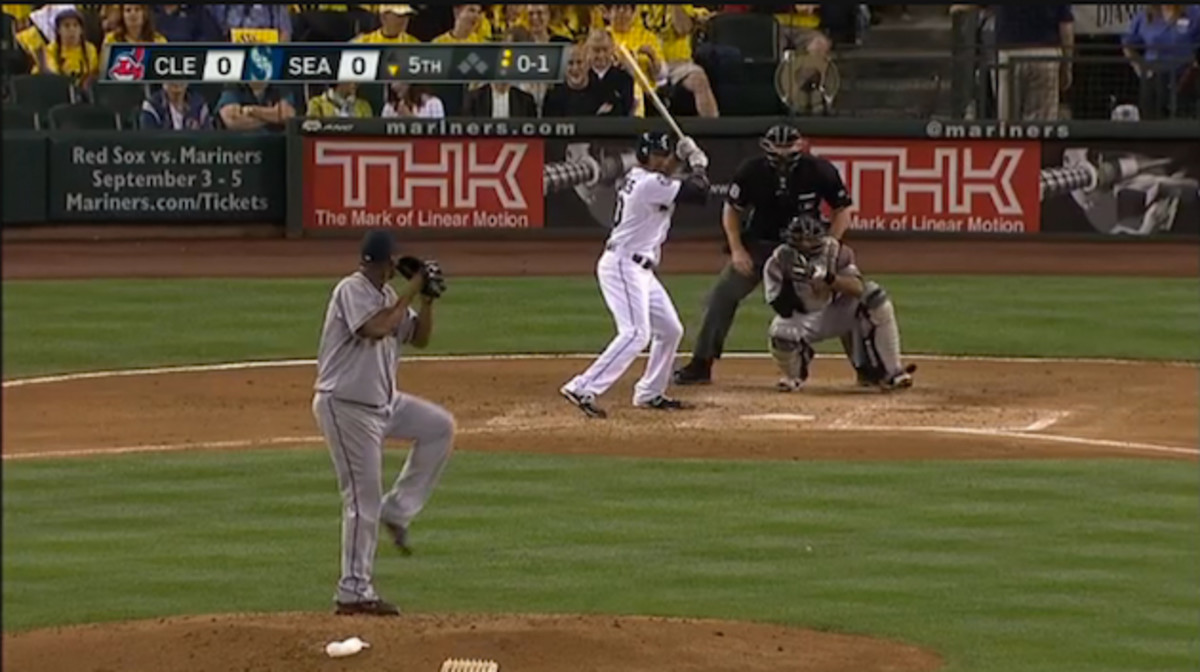
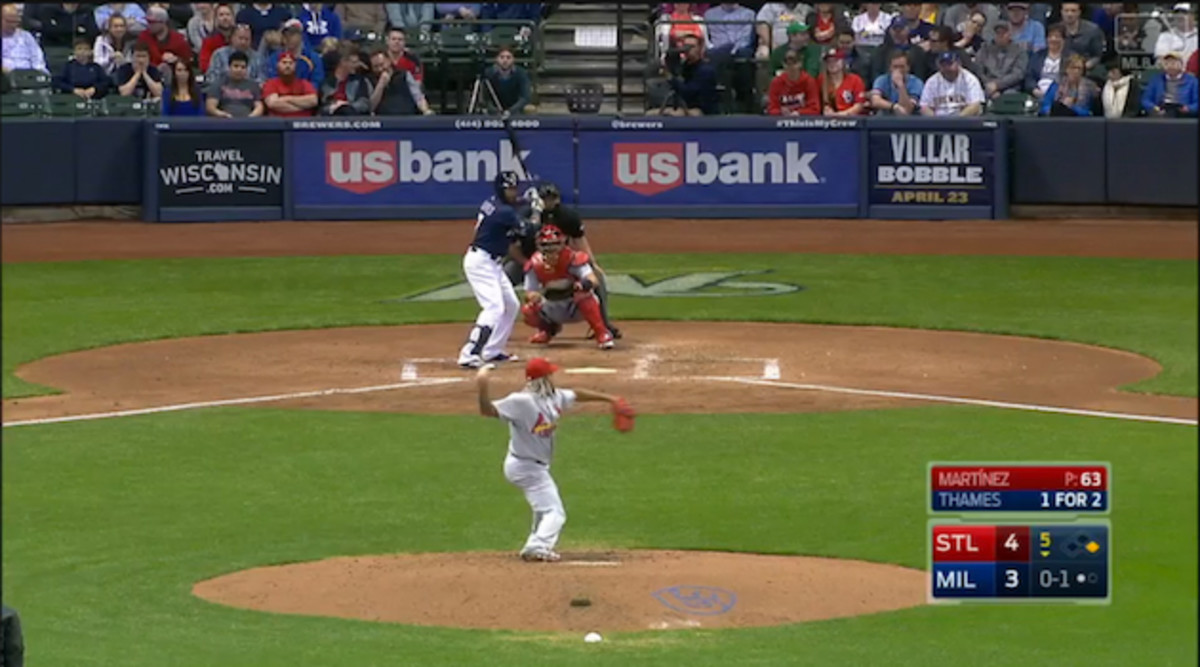
Where do we even start? Thames’s hands are lower, both as he’s waiting for the pitcher to begin his motion toward the plate, and when he goes into his load. His stance is still open, but not nearly as open as it once was, and his front foot is now flat on the ground. Previously, Thames’s front knee was bent back toward his back leg. Now it’s bent in a more traditional manner, giving him a wider base at the plate. The result is that he’s slightly more crouched in his stance.
“Controlling his head movement has been huge, because now he’s recognizing pitches early, and then he’s able to get into a hitting position that has allowed him to stay through balls on the inner half, and not rotate off pitches to give away the outer half of the plate,” Coles said.
Indeed, Thames is doing a better job of identifying and attacking pitches on which he can do serious damage. Even in his first stint in the majors, Thames was a dangerous low-ball hitter. Pitchers could exploit a hole in his swing up in the zone, however. The following zone profile, courtesy of Brooks Baseball, tells the story of a hitter who would make pitchers pay on low strikes, but was an easy out against elevated pitches. The zone profile shows Thames’s isolated power by zone. Isolated power is slugging percentage minus batting average, measuring a player’s ability to hit for extra-base power.
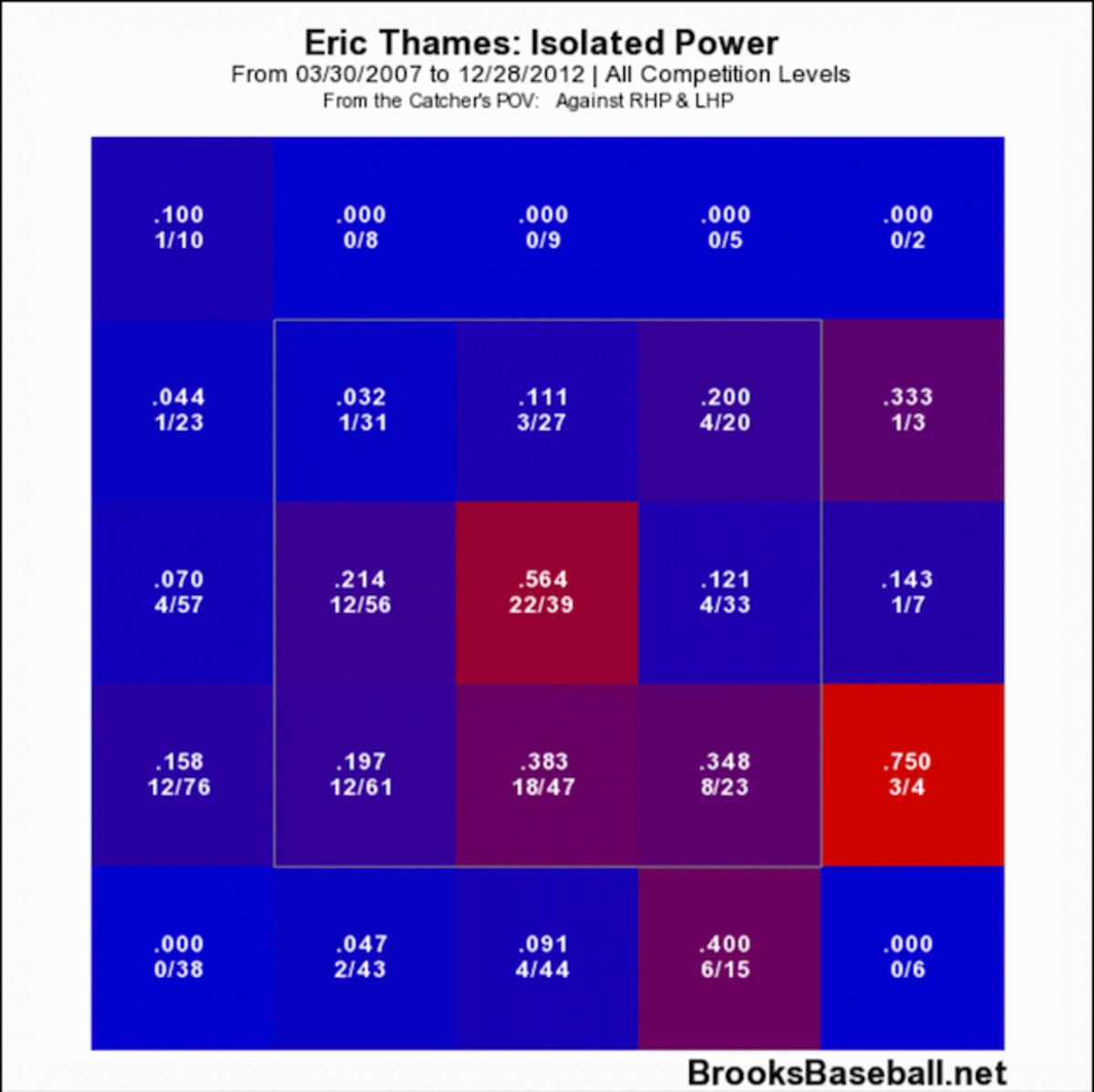
There’s nothing inherently wrong with a hitter who does far more damage on low pitches than high ones. In fact, that’s quite common for a lefthanded hitter. The problem, though, came with Thames’s lack of selectivity. The following zone profile shows his swing rates by zone in 2011 and ‘12.
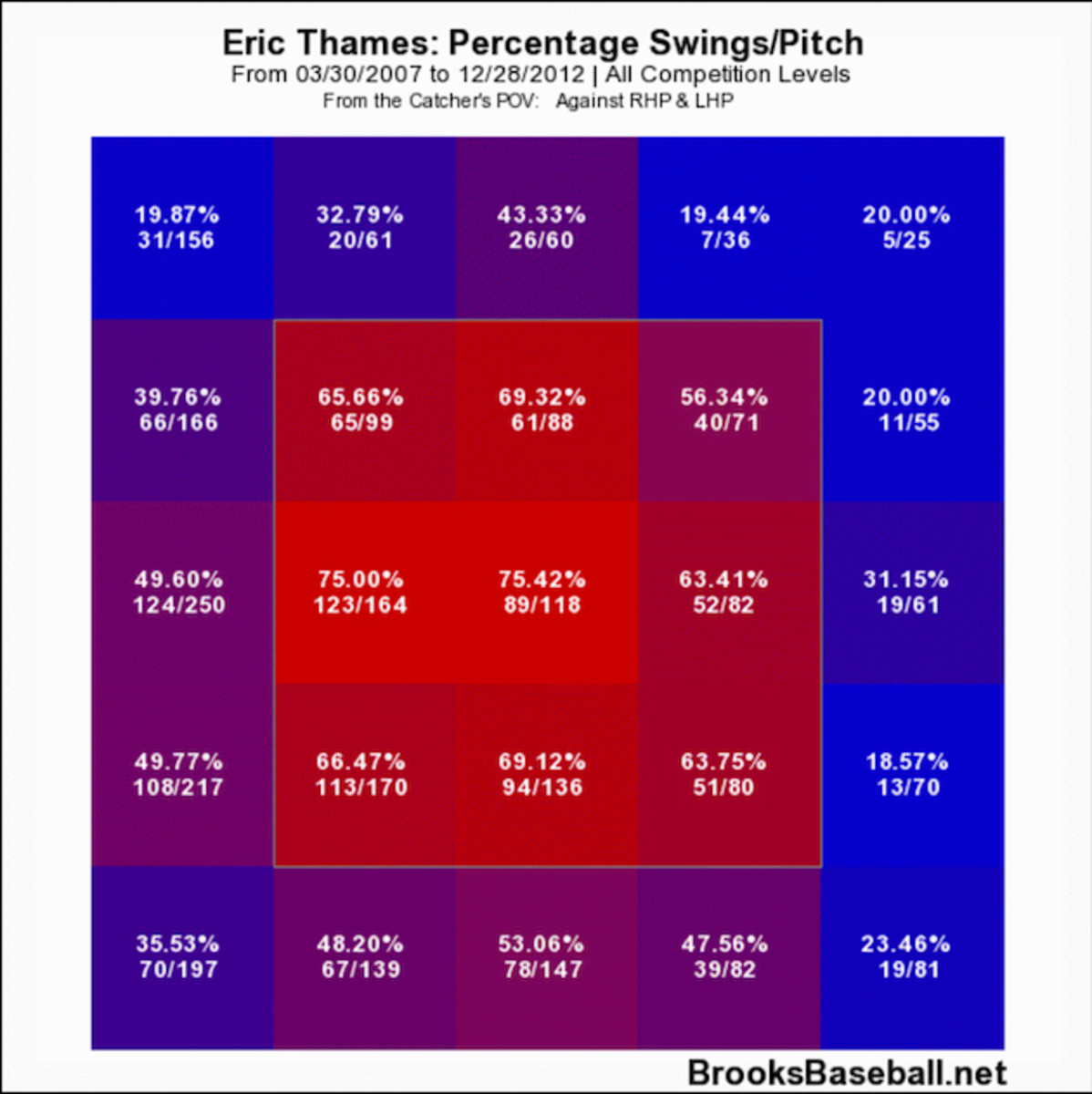
Thames swung just as often at strikes he couldn’t handle as those he could. He swung at just more than half of the pitches he saw in 2011 and ‘12, including more than 35% of those that were out of the strike zone. He swung-and-missed on 12.5% of the pitches thrown his way.
This season, Thames has still been aggressive on pitches in the strike zone, but he has tempered that aggressiveness up in the zone.
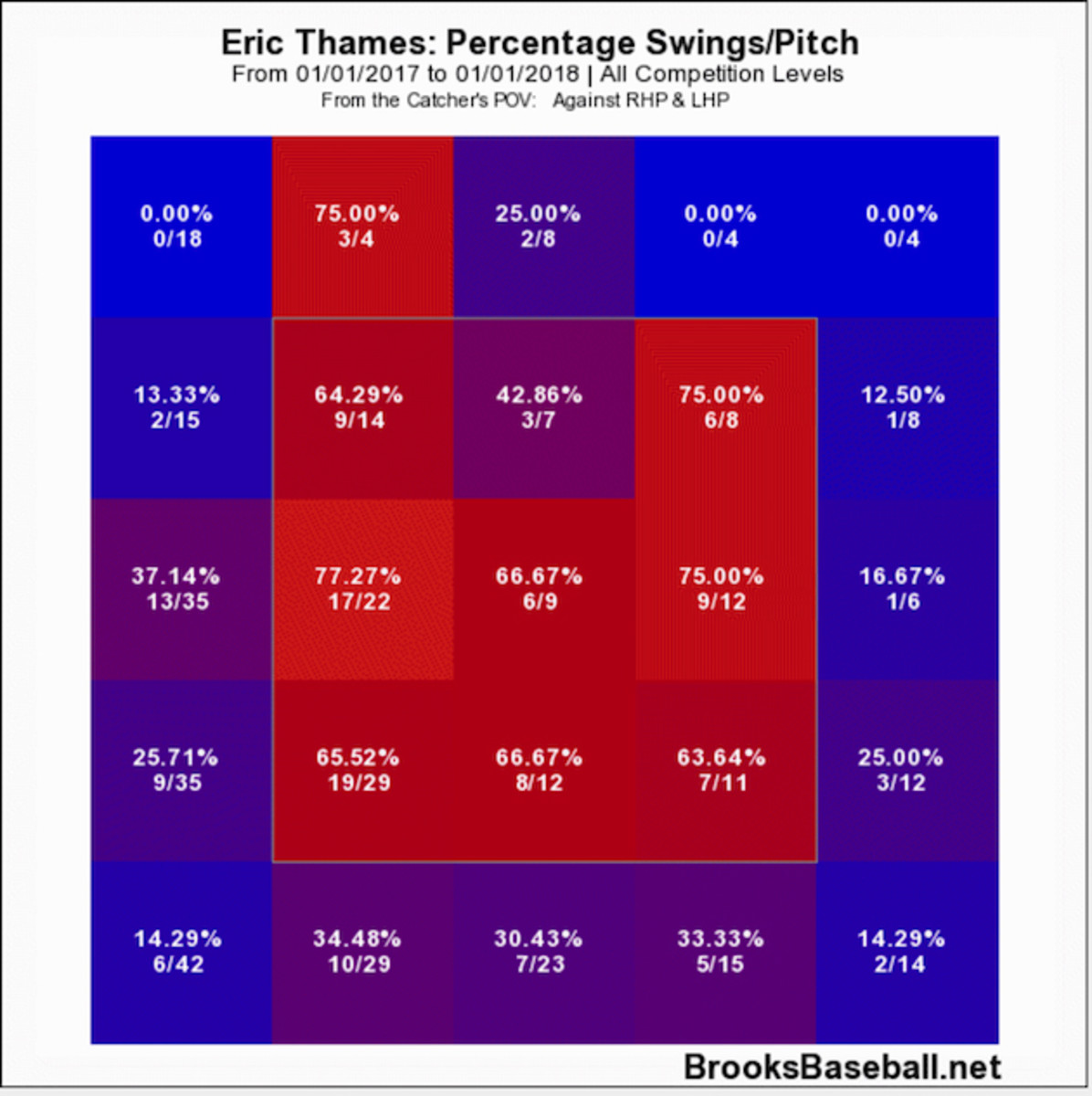
That’s a total swing rate of 62.1% on elevated pitches in the strike zone, compared with 64.3% during his first two seasons in the majors. What’s more, Thames offered at 26.3% of pitches above the strike zone as he was busy swinging himself out of the majors. This season, that number is down to 13.2%.
“He doesn’t look to pull the ball as much as he did in the past,” Coles says. “He has a good idea of what he wants to do and he doesn’t cheat the process. He always gets his early work done, and he always sits down and watches the pitcher to figure out how he feels they’re going to attack him. He has a good understanding of what his process is, and he doesn’t get away from that.
“At the end of the day, you’re still trying to make sure that you get a good pitch to hit because you’re only as good as what you’re swinging at,” Coles said. “Obviously he’s swinging the bat very well.”
That’s likely the biggest change between the pre- and post-KBo versions of Thames. He remains just as dangerous on pitches between his knees and his belt. His isolated power is .828 on pitches in those two locations. To give you a sense of how lethal that is, Mike Trout’s career ISO is .253. The big difference isn’t what Thames does on those pitches but that he’s more selective, laying off pitches up in the zone and attacking down in the zone. He’s putting pitches in his wheelhouse in play more often than ever before, and the results speak for themselves.
Both of those pitches are down in the zone, and Thames deposits them into the seats. The first one, on the outer third, he takes to left-centerfield. The second one, down and in, he drives to right-centerfield. There’s no good way for a pitcher to attack the bottom of the zone against Thames.
“I think that’s something he has learned over his playing career,” Coels said. “All players have strengths that you try to stay within the parameters of, and as you go about a long season you try to stay away from weaknesses, or work on weaknesses and get better at them. Irrespective of where his hot zones are, he has done a great job of not missing pitches in those zones.”
The 30: Nationals grab the top spot, Giants plummet toward the abyss
Thames’s swing itself isn’t markedly different from what we saw from him in 2011 and '12. He still strides forward and toward the plate, though he has less ground to cover with that step since his stance isn’t quite as open. His front foot also comes back to the ground sooner than it did previously, though that isn’t a substantive difference.
The major changes Thames made have also helped to improve his overall plate discipline. He has swung at just 39.1% of pitches overall, and 20.7% out of the zone. His whiff rate has plummeted to 8.7%. Previously, Thames was one of the most swing-happy hitters in the majors. This season, his swing rate ranks 175th in the league, and his o-swing rate, the frequency with which a hitter offers at pitches out of the strike zone, ranks 174th.
This makes life for pitchers facing Thames a vicious, self-fulfilling loop. He’s not going to swing at bad pitches, so they have to challenge him. If they don’t challenge him, Thames is happy to take the free pass. He has eight walks against 11 strikeouts this year, earning a base on balls in 15.5% of his plate appearances this year. He’s willing to work deep counts, thanks in large part to his discerning eye, laying off pitches up in the zone that either he can’t handle or doesn’t want to bother with. Though, if he wants to, Thames can still make a pitcher pay on high strikes, as the Cubs’ John Lackey learned last week.
Thames is thus regularly forcing pitchers to beat him on his terms. That is proving incredibly hard for them to do. Whether the hananim of the KBO can become the God of MLB remains to be seen, but Thames doesn’t need the nickname to confirm what is already true. His career resurrection on one side of the Pacific has made him a sight to behold on the other.
